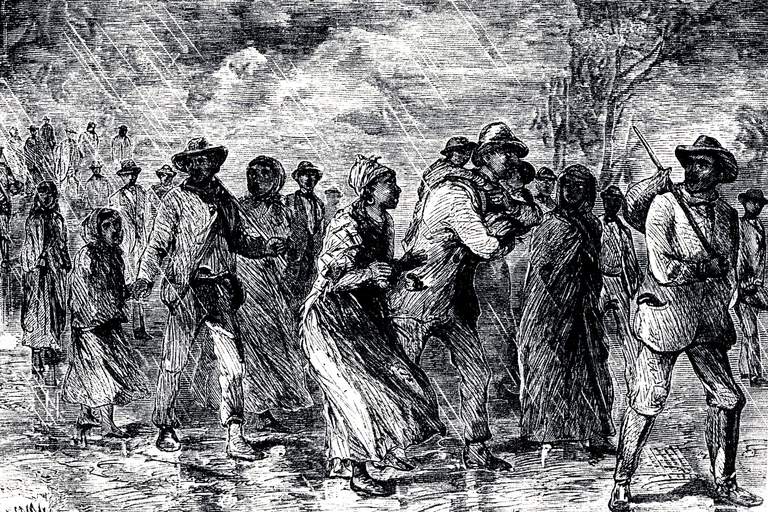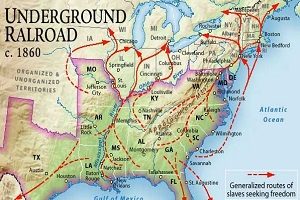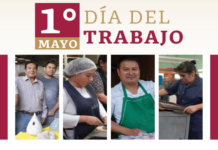The “Underground Railroad” to Mexico
By: Joseph W. Cote, MAT Oakland University, Rochester Hills, Michigan, U.S.A.
Editor’s Note: This article is part of a research project entitled, “Pathways to Freedom in the Americas” that was funded by the Dr. Martin Luther King, Jr. Task Force of Southfield, Michigan and the Michigan Humanities Council. This article was originally entitled, “Pathways of Freedom to Mexico: Rethinking the Underground Railroad 1810-1865” and is published with permission from the organization.
 African Americans seeking freedom not only relied upon their own instincts but also the complex network which extended from the aid of abolitionists and slave sympathizers.
African Americans seeking freedom not only relied upon their own instincts but also the complex network which extended from the aid of abolitionists and slave sympathizers.
The “Underground Railroad” was a systematic pathway to freedom that aided fugitive slaves in their escape from the bondage of slavery within the United States.
The traditional discussion surrounding this network describes a strategic line of farms zigzagging its way northward and extending into Canada.1 However, the north was not the only direction in which escapees to freedom took flight.2 According to historian Dr. Ernest Obadele-Starks, “Opportunities for escape increased when slaves lived in close proximity to free Africans, rivers, free states and territories, foreign borders of nations that prohibited slavery and the slave trade, or areas where runaways congregated.” 3
The proximity between Texas and Mexico contained such opportunities for escape to those Americans seeking relief from the oppression of slavery.
Flight after the Mexican-American War
The realization of a pathway to freedom and Mexico can be traced through the maturation of establishing a link. Historian Sean M. Kelley has divided this process into three periods. The first period occurred prior to 1820 as the Mexican War broke out seeking independence from Spain in 1810. During this period attention was brought to the boundary between the U.S. and Mexico as the new state of Coahuila had been added to Mexico. By 1819, the boundary dispute had been resolved as Spain and the United States negotiated the Coahuila-Texas border. The institution of slavery was legal in both regions during this period. Because of this, Kelley suggests that slaves escaping their bondage in Texas sought a pathway to freedom into Mexico, since it would be difficult for slave owners to pursue them into Spanish territory. 4
Mexico Outlaws Slavery and Guarantees Freedom to Americans
During the second period, 1820 to 1829, the linkage of the pathway to freedom and Mexico began to take root within the slave community. Once Mexico had gained independence from Spain in 1821, Mexican law began to attack the institution of slavery within its own borders. One such law in 1824, passed by the Sovereign General Constituent Congress, outlawed the commerce and traffic of slaves within Mexico. 5
However, the law that established a concrete link between the pathway to freedom and Mexico occurred on September 15, 1829, when President Vicente Guerrero officially abolished slavery within Mexico. Furthermore, the law granted freedom to those, “who have been locked up as slaves.” 6 Kelley suggests that this crucial law created a “faint connection between Mexico and the idea of freedom,” for those held in bondage within Texas and the United States.7
The third period, 1829 to 1845, solidified the linkage between the pathway to freedom and Mexico as tensions rose over the issue of slavery between Mexico, Texas, and the United States. 8 This link would only get stronger with the annexation of Texas, and its admittance into the Union as a slave state.
African Americans Cross the Rio Grande River!
The geography between Texas and Coahuila, Mexico created a natural pathway to freedom for enslaved African-Americans to escape. The geographical features neighboring both sides of the Rio Grande River included level plains, rolling prairies, and low hills for the first five hundred and fifty miles. Furthermore, a dense growth of shrubs and trees covered the lands along the river furnishing a natural hiding location. The river could be crossed by boat, or by one of the numerous areas where water was shallow enough to cross on foot.9 One example of a river crossing occurred when former slave Sallie Wroe’s father escaped during the Civil War. He had paddled a “bale of cotton,” across the Rio Grande.10
Those that chose the pathway to freedom into Mexico did so on the basis of their proximity. According to Obadele-Starks, “The movement of slaves out of the Western Gulf South states was linked almost exclusively with Mexico.” 11 This was done as the proximity to the pathway of freedom into Mexico was shorter than the northern route of the Underground Railroad into Canada. While debating the Compromise of 1850, Texas Senator Sam Houston pointed out that his state was similar to border states much like Maryland or Kentucky, and that, “Mexico was nearer to Texas than Canada was to slave states.” Furthermore, Houston added, “Slaves often found refuge south of the Rio Grande.” 12
The United States Officially Recognizes the Underground Railroad to Mexico
The importance of this Pathway to Freedom – The Underground Railroad to Mexico – was recognized by the United States government as Congress enacted Public Law 101-628 on November 28, 1990, which directed the National Park Service to conduct a study of alternatives for commemorating the Underground Railroad which included sites and pathways into Mexico. 13
References:
- Henrietta Buckmaster, “The Underground Railroad,” The Journal of Negro History 18, no. 2 (April 1933): 144. S.G. Howe, The Refugees From Slavery in Canada West: Report to the Freedmen’s Inquiry Commission (Boston: Wright & Potter, Printers, 1864), 12.
- Delores E. Preston Jr., “The Genesis of the Underground Railroad,” The North American Review 246, no.1 (Autumn 1938): 142.
- Ernest Obadele-Starks, Freebooters, and Smugglers: The Foreign Slave Trade in the United States After 1808 (Fayetteville: University of Arkansas, 2007), 120.
- Kelley, “Mexico in His Head: Slavery and the Texas-Mexico Border, 1810-1860,” Journal of Social History 37, no. 3 (Spring 2004): 710-711.
- The Prohibition of the Commerce and Traffic in Slaves Decree, July 13, 1824, special focus on articles 1 and 2. 1. The commerce and traffic in slaves, proceeding from whatever power, and under whatever flag, is forever prohibited, within the territories of the United Mexican States. 2. The slaves, who may be introduced contrary to the tenor of the preceding article, shall remain free in consequence of treading the Mexican soil, Benjamin Lundy, The Anti-Texas [sic] Legion. Protest of Some Free Men, States, and Presses Against the Texas [sic] Rebellion; Against the Laws of Nature and of Nations (Albany, New York: Patriot Office, 1845), 9.
- Ibid, 10.
- Kelley, 710.
- Ibid.
- Fred J. Rippy, “Border Troubles Along the Rio Grande, 1848-1860,” The Southwestern Historical Quarterly 23, no. 2 (October 1919): 91.
- Kelley, 719.
- Obadele-Starks, 126.
- Ronnie C. Tyler, “Fugitive Slaves in Mexico,”The Journal of Negro History 57, no. 1 (January 1972): 1.
- Linda Russo, ed. Special Resource Study Management Concepts / Environmental Assessment: Underground Railroad. (United States Printing Office: United States Department of Interior – National Park Service, 1996), 3. Also, see map, 32.











